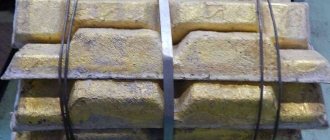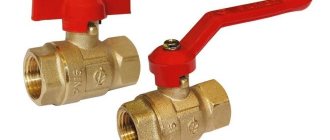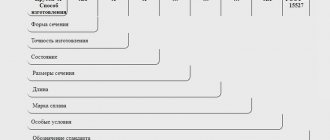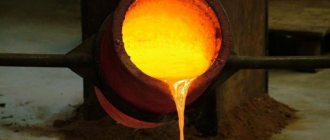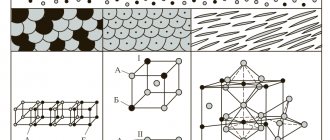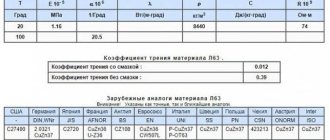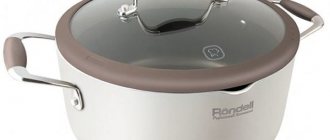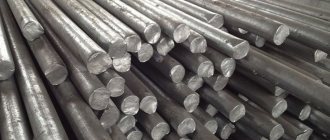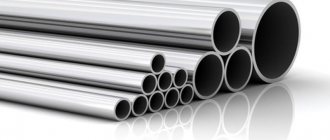Brass LO70-1 Brass LMtsA57-3-1 Brass LMtsAZhKS70-7-5-2-2-1 Brass LMtsZh57-1.5-0.75 Brass LMtsKA58-2-1-1 Brass LMtsKNS58-3-1.5-1 ,5-1 Brass LMtsKNSA58-3-1.5-1.5-1 Brass LMtsSKa58-2-2-1-1 Brass LMsh68-0.05 Brass LN65-5 Brass LNKMts49-10-0.3-0.2 Brass LNKoMts49-9-0.2-0.2 Brass LNMts60-9-5 Brass LO60-1 Brass LO62-1 Brass LKS65-1.5-3 Brass LO90-1 Brass LOK59-1-0.3 Brass LOMNA49-0 ,5-10-0.4-0.4 Brass LOMsh70-1-0.04 Brass LOMsh70-1-0.05 Brass LS58-2 Brass LS58-3 Brass LS59-1 Brass LS59-1V Brass LS59-2 Brass LS60 -1 Brass LS63-3 Brass LS64-2 Brass LS74-3 Brass LA85-0.5 Brass L59 Brass L60 Brass L63 Brass L66 Brass L68 Brass L70 Brass L72 Brass L75mk Brass L80 Brass L85 Brass L90 Brass L96 Brass LA77-2 La Tun LA77 -2u Brass LMts58-2 Brass LAZ60-1-1 (LAZH60-1-1L) Brass LAZHMtsS52-2-1-1.5-1 Brass LAMsh77-2-0.04 Brass LAMsh77-2-0.05 Brass LAN59- 3-2 Brass LANKMts 75-2-2.5-0.5-0.5 (alloy 156) Brass LAF94-0.5-0.15 Brass LZhMts59-1-1 Brass LZhS58-1-1 Brass LK62-0 .5 Brass LK75V Brass LKAN80-1-1.9-5.8 Brass LKANMTs75-2-2.5-0.5-0.5 Brass LKBO62-0.2-0.04-0.5
Description
Brass L90 is used : for the production of semi-finished products (tapes, sheets, strips, rods); various parts by cold deformation by deep drawing, drawing, rolling, embossing, bending; as an active layer of thermobimetals used for the manufacture of temperature-sensitive elements of instrumentation and apparatus; wires for electrical parts; medals and badges; radiator tapes intended for the manufacture of cooling tubes and radiator plates; Tompak cold-rolled strips and strips used for cladding; tape with a thickness of 0.5−1.08 mm, intended for the production of elements of target cartridges; extruded rods with a diameter of 60 to 120 mm for the shipbuilding industry.
Note
Plain (double) brass. L90 brass deforms very well in a cold state, especially by drawing; not prone to corrosion cracking; Suitable for forging, embossing, enameling.
Areas of application
Tompak, the products from which have a very beautiful color, is actively used in jewelry due to its good workability. Individual jewelry is made from it, and products made of gold, silver and other metals are decorated with it. Due to the exceptional decorative characteristics of tombak, it is used to make furniture elements, dishes, figurines, and other interior items.
Tombac bowl and jug
The production of jewelry and decorative items is not the only area of application for this type of brass. Tompak is also used in various branches of modern industry. In particular, wire is produced from such an alloy, which can be used for various purposes. Dishes made from tombac are very popular (especially in the countries of Central Asia) (water jugs, trays on which it is quite easy to apply any pattern, as well as colanders and other household items). Since brass reacts quite critically to contact with water, dishes made from tombak must be tinning using tin.
Standards
| Name | Code | Standards |
| Ribbons | B34 | GOST 10533-86 |
| Ribbons | B54 | GOST 2205-71, GOST 8036-79, GOST 20707-80, GOST 15527-2004, GOST 2208-2007, OST 4.021.078-92, TU 1845-106-090-2001, TU 48-21-606-90, TU 48-21-654-92, TU 48-21-666-79, TU 48-21-602-88 |
| Non-ferrous metals, including rare ones, and their alloys | B51 | GOST 28873-90 |
| Sheets and strips | B53 | GOST 931-90 |
| Rods | B55 | TU 48-21-816-86 |
Material L90 Chelyabinsk
Not a single production can operate without steel, be it heavy engineering or the manufacture of household electrical appliances. There are many brands of this product, as well as a large number of dispensing forms. Our company sells L90 material in large quantities and with a minimal margin. To clarify the properties and characteristics of a particular brand, you can contact the company’s managers.
Like all products, L90 material is purchased from leading manufacturers. Therefore, we are ready to provide a quality guarantee with full responsibility. The minimum number of intermediaries determines the low cost. Coupled with fast delivery, this enables our business partners to conduct stable and mutually beneficial cooperation.
In addition to tempering, in the form of one or another part (blank), our company carries out metal processing. All events undergo strict control for compliance with GOST and rules. The specialists of our company carry out such work as galvanizing, creating parts according to customer drawings, producing castings, manufacturing various profiles and much more.
Having the latest equipment and vast experience in our arsenal, we can offer product testing for a number of parameters, such as strength characteristics, chemical composition, alloy purity, and so on.
Each buyer is offered a huge range of products in various formats, as well as current services and works. To quickly understand and choose a product that meets your needs, you need to contact the company manager and receive detailed information on all issues of interest.
Chemical composition
| Standard | P | Fe | Cu | Zn | Sb | Pb | Bi |
| GOST 2208-2007 | ≤0.01 | ≤0.1 | 88-91 | Remainder | ≤0.005 | ≤0.03 | ≤0.002 |
Cu is the base. According to GOST 15527-2004, GOST 2208-2007, TU 48-21-816-86, the sum of other elements must be ≤ 0.20%. In brass, a mass fraction of nickel of up to 0.30% is allowed due to the mass fraction of copper, which is not taken into account in the sum of other impurities. For antimagnetic brass, the mass fraction of iron should not exceed 0.030%.
What is brass
The main components of brass alloy are copper and zinc. The proportional components of these metals may be different. The amount of zinc varies. Its minimum value is 20%. The maximum reaches 50%. At the same time, the alloy changes its color: it can be golden, yellow or green.
The percentage of zinc is so important that it can change the characteristics of the material. This refers to its ductility and hardness.
Properties and composition of pseudo-precious brass
Brass has been known for a very long time, since the times of the ancient Romans, and this despite the fact that zinc was discovered only 5 centuries ago. In those distant times of antiquity, galmei (zinc ore) was added to the mentioned alloy instead of pure Zn. But the tombac that we know today was invented by Christopher Pinchbecker in the 17th century. The alloy became widespread not only in England; within a few decades people learned about it all over the world. And by the way, many scammers got rich by passing off coins, various jewelry and products made from this type of brass as gold. Today in everyday life you can find other names for this alloy - similor, princetal, chrysochalk, oreid and chrysorin.
As you may have guessed, it is an alloy of copper and zinc. The content of the first element ranges from 88 to 97%, and the second - no more than 10%. If you increase the share of Zn to 10–20%, then you get a semi-tompak. The content of the last element affects the properties of brass and its color. As it increases, the color changes from red to yellow. Sometimes tombac bars can be confused with precious gold in the photo. Such a change leads to improved antifriction, technological and mechanical properties, and the cost, on the contrary, decreases. This is due to the relative cheapness of zinc compared to copper.
The material has excellent anti-corrosion properties and wear resistance. It welds perfectly with various steels and precious metals. It is distinguished by increased plasticity. Easily amenable to enameling and gilding, forging, drawing and engraving.
Another feature is the complete absence of magnetic properties.
Product made from tombak
The hardness of the material reaches 145 MPa. The temperature at which the melting process begins is 1045 °C. Without the use of lubricant, the friction coefficient is 0.44. If you use special lubricants, this figure can be reduced to 0.074. Tensile strength ranges from 440 to 520 MPa, and elongation after break is about 3%. Brass L90 has a density of 8780 kg/m3. To obtain the specified characteristics, additional elements are introduced into the composition of the tombac alloy. Their content is only a few tenths of a percent. The result is a material with an ideal ratio of ductility and strength, excellent appearance and reasonable price.
The alloy, depending on the further fate, can be sheet or in bars. The marking indicates the letter “L” first, followed by the percentage of copper. For example, L96 consists of 95–97% Cu, no more than 0.2% impurities and the rest is Zn. But if you see the designation L90 on a product, it means that the main element is contained within 88–91%, impurities are less than 0.2%. Brands L85 and L80 belong to semi-tompak. The share of additional components in them can reach 0.3%.
Characteristics
The main quality in the characteristics of brass is its corrosion resistance. But it also has other properties:
- The ability of the alloy to withstand aggressive environments, especially after coating the surface with varnish.
- Strength of brass.
- Plasticity of the alloy.
- The ability of the material to be processed by pressure. The process is carried out both hot at high temperatures and cold.
- The alloy can be subjected to resistance welding and soldering.
- Thermal conductivity, which increases with increasing percentage of copper.
- Melting point, which is 880–950 degrees. With less zinc added, the melting point decreases.
- The material has non-magnetic properties.
The main factor in the hardness and ductility of the joint is zinc. An increase in its quantitative content is directly related to an increase in strength characteristics. Plasticity increases only up to a quantitative zinc content of 36%. With a subsequent increase to 45%, this indicator decreases.
In order to increase the hardness of the alloy, a heat treatment called cold hardening is carried out. It helps not only to increase the strength index, but also relieves internal, structural stresses.
Alloying additives affect the performance characteristics. Their influence is indicated in the table:
| Name of alloying element | Effect on brass characteristics |
| Silicon | Its high presence leads to a decrease in the hardness of brass. |
| Lead | Improves anti-friction properties. |
| Manganese, aluminum and tin | Increases resistance to tearing. Corrosion resistance is increasing. |
| Nickel | Reduces the risk of material cracking. The alloy acquires a peculiar color. This connection is called “white brass”. |
| Arsenic | The material has the ability to work in liquid, fresh media. |
Marking
There are 2 types of alloys:
- Two-component. The main components are copper and zinc. They are marked with the letter L. Next are numbers indicating the amount of copper in percent. L60: contains 60% copper, and the remaining 40% zinc.
- Multicomponent. In addition to the main components, alloying elements are added. Also in front is the letter L. Then follows a list of additives. At the end, numbers are written through a dash indicating the percentage of each component. The amount of zinc is not indicated, but calculated. For example: Brand LAZhMts66-6-3-2 has 66% Cu, 6% Al, 3% Fe and 2% Mn. By calculation, the amount of zinc is determined to be 23%.
How to distinguish gold from brass
Even though gold and brass look similar, there are ways to tell one from the other. This is checked as follows:
- Gold has a more saturated color. In addition, over time, brass darkens because it oxidizes in air, but gold does not.
- If you put a magnet near it, brass will be attracted, but gold will not.
- Brass has a higher density, which means it is heavier. This is noticeable when throwing pieces of metal in your palms.
- Availability of sample.
- If you test with acid, the gold will not react and the brass will discolor.
This is interesting: Metal turning. Features of the process and necessary equipment
Advantages and disadvantages
Brass alloy has characteristics that are positive in one case and negative in another. They consist of the following:
- Light weight. This quality, together with high strength, is used in certain industries.
- The alloy has good ductility.
- Low cost.
- Corrosion resistance decreases with increasing amount of copper.
- Thermal conductivity indicators are lower than those of pure copper and bronze.
Mechanical characteristics
| Section, mm | σB, MPa | d10 | Brinell hardness, MPa | HV, MPa |
| Cold-rolled strip of rectangular cross-section, thickness 0.5-1.08 mm as delivered in accordance with GOST 8036-79 | ||||
| ≥250 | ≥38 | — | — | |
| Cold-rolled tapes (0.25-0.45 mm) and strips (2.5-4.0 mm) as delivered in accordance with GOST 2205-71, cold-rolled tapes (0.1-2.0 mm) in accordance with OST 4.021.078 -92 | ||||
| 230-370 | ≥36 | — | — | |
| Cold-rolled sheets and strips in delivery condition in accordance with GOST 931-90, sheets and strips in accordance with GOST 2208-2007 (samples) | ||||
| — | 230-340 | ≥36 | ≥60 | ≥65 |
| — | 290-390 | ≥10 | ≥85 | ≥90 |
| — | ≥350 | ≥3 | ≥110 | ≥120 |
| Pressed rods as delivered according to TU 48-21-816-86 | ||||
| — | ≥196 | ≥30 | — | — |
What is tompak?
Tompak is one of the many varieties of brass, which combines zinc and copper in a certain proportion. The comparison of this metal with gold is based only on external similarity, since in terms of chemical composition, characteristics and other features, these two metals are completely different. Although brass has been known to mankind for a long time, they first started talking about tombac only in the eighteenth century - after the discovery made by Christopher Pinchbecker. At that time, a similar alloy was actively used in England. And only a few decades later its popularity spread to other countries.
On the similarity of tombac to a jewelry mineral, many dishonest people were able to make good money by passing off coins and jewelry made of brass alloy as real ones made of gold.
The metal in question can be called similore, princetal, chrysorine, chrysochalk, ororeid. When you hear these names, don’t be surprised - they’re all the same metal.
Tombak has many advantages:
- good resistance to corrosion damage;
- excellent wear resistance;
- good weldability with other metals;
- plasticity is sufficient for the use of deformation and engraving methods;
- possibility of enameling and gilding;
- immunity to magnets.
One type of metal, called semi-tompak, deserves special attention. Its difference from tombak lies in the percentage of zinc, which can range from 10–20%. This feature explains the change in the basic properties of the metal:
- rich yellow color;
- decreased plasticity;
- increased refractoriness.
Such characteristics make it possible to use semi-tombak for the production of some technical parts. This type of metal is less common compared to tombac. This is due to the presence of a large number of deficiencies due to the high zinc content in it.
A little history
This alloy has been known since the times of ancient South American pre-Columbian civilizations; brass jewelry, dishes, and tools were found during archaeological excavations. Instead of zinc, the production secret of which was lost in Europe in the 10th-11th centuries and rediscovered only a few centuries ago, the alloy was made at that time using rich zinc-containing ore - galmey (a mixture of zinc spar ZnCO3 and zinc silicate).
The tombac was reinvented in England by the London watchmaker Christopher Pinchbecker (1670 - 1732). It is he who is considered the author of the chemical composition of this alloy. Initially, the alloy was used to make chains and watch parts. But soon tombak became widespread not only in England, it became known all over the world. Many fortunes were made by various scammers based on the similarity of tombac to gold; they became rich by passing off coins and items made from it as gold.
Marking
Tombak, cast in bars or made in the form of rolled sheets, is marked with the designation “L90”, where “L” is brass, and the number “90” means the percentage of copper content. Impurities in such an alloy are less than 0.2%. “L96” means that the alloy is 95-97% copper, no more than 0.2% impurities, the rest is zinc. If the number on the marking is “85” or less, then it is not a tombac, but a semi-tompak. And this means that the amount of zinc in the alloy is more than 10%, its ratio can reach up to 22%. The amount of additional components can reach 0.3%. By increasing the volume of zinc, the basic properties of the alloy change:
- the color changes, it becomes more yellow;
- the degree of plasticity decreases;
- refractoriness increases.
This material is more often used for the manufacture of technical parts; bellows, flexible hoses, condensation tubes, and wire mesh used in filter-driers for refrigeration machines are made from it.
Production methods
Today, tombak can be produced using a variety of technologies. The most widely used option is the use of an electric oven, which heats the composition to 1400 degrees Celsius. When exposed to such a temperature, silicate is released, which floats to the surface and is removed.
Among other features, we note the following:
- The result is base metal, which is poured into a special container. There are quite a large number of different devices whose purpose is to release tombak. The base composition must be heated to a temperature of 1400 degrees Celsius. In this case, certain safety rules must be observed.
- The next step is to flush the resulting composition with oxygen. Special equipment is also used for this. The purging procedure leads to the active release of thermal energy and a chemical reaction.
- As a result of a chemical reaction when exposed to oxygen, copper is formed. It is characterized by the fact that it has a large number of various impurities, due to which the properties are significantly reduced.
- Next, the composition is electrically cleaned using special acidified copper sulfate.
- Zinc is introduced into the resulting straightened copper. This material increases strength and corrosion resistance.
The above information indicates that the process of obtaining such a composition is quite complex and time-consuming. That is why the cost of tombak is quite high, but much less than the cost of the precious metal.
Do not forget that tombac is an alloy of copper and zinc. This composition has very attractive characteristics and is used in the creation of various high-precision measuring and other equipment. In addition, decorative characteristics are highly valued. At a certain ratio of the main components, the alloy resembles gold, but the properties are significantly different.
Production methods
Methods for obtaining tombak have expanded significantly since its discovery, but the essence of each of them comes down to a single scheme.
- The composition is heated in an electric oven to 1300–1400 degrees. With such heating, silicate is released, floating to the surface of the alloy, which makes it possible to remove it from there without unnecessary difficulties.
- The resulting metal is poured into a container and purged with oxygen. This stage requires the use of special equipment. This treatment provokes the release of thermal energy in large quantities and triggers a chemical reaction.
- At this stage, copper is formed, which contains many impurities, which reduces its properties.
- The composition is subjected to electrical cleaning using acidified copper sulfate.
- Zinc is added to molten copper to produce a strong alloy with high corrosion resistance.
The process of obtaining tombak is complex, labor-intensive and energy-consuming. This explains the high cost of the metal, which is still much lower than the price of gold.
